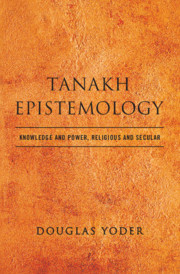Book contents
- Tanakh Epistemology
- Tanakh Epistemology
- Copyright page
- Dedication
- Contents
- Preface
- Acknowledgments
- Introduction
- 1 Reading Epistemology in the Tanakh
- 2 Unveiling Knowledge/Power
- 3 Apokalypto, Revelation, Imperium
- 4 A Revelatory Observable
- 5 Sees Hears Knows
- 6 Qoheleth’s Critique of Wisdom, Knowledge, and Critical Thought
- 7 Tanakh Epistemology in Modernity
- 8 Tanakh Epistemology and Postmodernism
- 9 Synthesis
- 10 Consequences
- Conclusion
- References
- Tanakh References
- Index
2 - Unveiling Knowledge/Power
Published online by Cambridge University Press: 28 April 2020
- Tanakh Epistemology
- Tanakh Epistemology
- Copyright page
- Dedication
- Contents
- Preface
- Acknowledgments
- Introduction
- 1 Reading Epistemology in the Tanakh
- 2 Unveiling Knowledge/Power
- 3 Apokalypto, Revelation, Imperium
- 4 A Revelatory Observable
- 5 Sees Hears Knows
- 6 Qoheleth’s Critique of Wisdom, Knowledge, and Critical Thought
- 7 Tanakh Epistemology in Modernity
- 8 Tanakh Epistemology and Postmodernism
- 9 Synthesis
- 10 Consequences
- Conclusion
- References
- Tanakh References
- Index
Summary
Powerful visual imagery appears in the midst of a narrative constitutively concerned with knowledge in a chapter of the Tanakh where yada appears nearly twice as often – nineteen times – as in any other chapter. Where is this passage? Not in Genesis, Deuteronomy, Isaiah, Ezekiel, Proverbs, Job, or Qoheleth. The chapter with the highest frequency of “know” is Daniel 2, and that, due not least to the approach to Daniel of biblical criticism, is surprising.
- Type
- Chapter
- Information
- Tanakh EpistemologyKnowledge and Power, Religious and Secular, pp. 40 - 62Publisher: Cambridge University PressPrint publication year: 2020

